
Web app development focuses on creating interactive and scalable applications accessible through web browsers. Businesses build progressive web apps (PWA) by utilising front-end and back-end technologies that offer consistent user experiences, cross-platform compatibility, and improved accessibility without requiring installation on devices.
According to the Bureau of Labour Statistics, the web development market is robust in the US, with a projected 8% growth in employment for web developers and digital designers by 2033. The market size of web apps was reported to be around $43.5 billion in 2024.
The best web app development frameworks support full-stack development, enhancing performance and flexibility. Front-end frameworks like React, Vue.js, and Angular ensure dynamic user interfaces, while back-end frameworks like Node.js, Django, and Laravel manage server-side logic. These tools facilitate API integration and management, allowing error-free data exchange between applications.
Several programming languages power modern web development, each catering to specific needs. JavaScript and TypeScript dominate front-end development, while Python, PHP, Ruby, and Java excel in back-end frameworks. Effective database management systems like MySQL, PostgreSQL, and MongoDB store and retrieve application data efficiently.
When developing a web app, businesses follow a structured app development process involving planning, designing, coding, testing, and deployment. Ensuring secure user authentication, taking advantage of cloud hosting and deployment, and adhering to responsive web design principles optimise web performance. Partnering with a reliable and expert web app development company ensures scalable, high-performance applications customised to user needs.
What Is Web App Development?
Web app development is the process of creating interactive applications that run on web browsers, accessible across various devices without requiring installation. It is important for businesses as it enables efficient user experiences, scalability, and accessibility from any internet-connected device. Web apps support e-commerce, collaboration, content management, and financial services. Examples of iOS apps that also offer web versions include Slack, Trello, and Dropbox.
What Is a Web App?
A web app is an application that operates through a web browser rather than being installed on a device. It consists of a front end (user interface), a back end (server-side logic), and a database for storing data. Examples of widely used web apps include MailChimp, Google Docs, Notion, Airtable, Xero, and Salesforce. Web apps offer advantages like easy updates, cross-platform compatibility, and reduced storage requirements but are limited by browser constraints and internet dependency.
What are the Best Frameworks and Tools for Web App Development?
The best frameworks and tools for web app development are React, Vue.js, Angular, Svelte, Solid.js, Node.js, Django, Flask, Ruby on Rails, and various databases and UI libraries. These frameworks facilitate development, enhance performance, and ensure a smooth user journey.
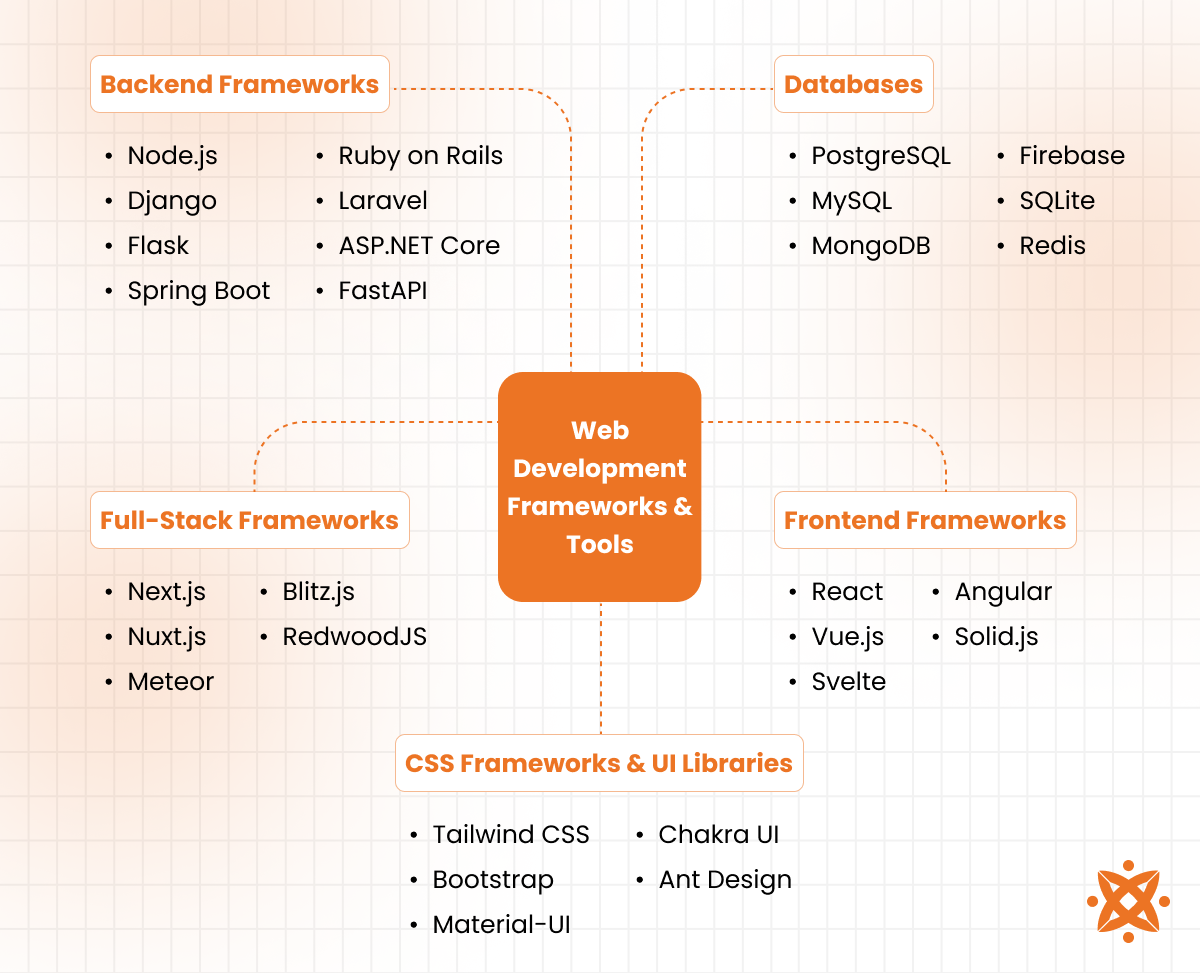
The best frameworks and tools for web app development are as follows:
Frontend Web App Development Frameworks
Frontend web app development frameworks enable the creation of dynamic and visually engaging user interfaces by handling the presentation layer of web applications. These frameworks simplify development by providing reusable components and efficient rendering mechanisms.
The frontend web app development frameworks are as follows:
- React: React is a JavaScript library developed by Facebook in 2013. React is widely used for building dynamic user interfaces. It uses JavaScript and JSX, supports cross-platform development through React Native, and offers component-based architecture, making it highly reusable and scalable. The required tools for this framework include Node.js, npm/yarn, and a code editor like VS Code.
- Vue.js: Vue.js is a progressive JavaScript framework released in 2014. It simplifies UI development with its reactive data-binding and component-based architecture. Vue.js primarily uses JavaScript and TypeScript, supports cross-platform apps through Vue Native, and is beginner-friendly with minimal tooling requirements like Vue CLI and Node.js.
- Angular: Angular is a TypeScript-based framework developed by Google in 2016. It offers robust tools for enterprise-scale web applications. Angular supports cross-platform development via Ionic and requires a steeper learning curve due to its complex structure. Fundamental tools for this framework include Angular CLI and RxJS.
- Svelte: Introduced in 2016, Svelte shifts the complexity from runtime to build time, generating highly optimised JavaScript code. It does not rely on a virtual DOM, making it lightweight and fast. It supports cross-platform development and requires minimal setup with tools like SvelteKit.
- Solid.js: Solid.js is a modern JavaScript framework launched in 2021. It emphasises fine-grained reactivity without a virtual DOM. Solid.js uses JavaScript and TypeScript, offers fast performance, and requires setup tools like Vite and npm/yarn.
Backend Web App Development Frameworks
Backend web app development frameworks power the server-side logic, managing data processing, authentication, and business logic. They simplify web app performance by offering robust tools for database interactions, API integrations, and server management.
The backend web app development frameworks are as follows:
- Node.js (Express.js, NestJS): Node.js is the runtime environment for JavaScript built on Chrome's V8 engine. Introduced in 2009, it enables scalable, non-blocking I/O applications. Express.js is minimalistic, while NestJS provides a structured, modular approach. Node.js supports cross-platform development and integrates well with modern tools like Docker and TypeScript.
- Django: Django is a Python-based framework introduced in 2005 that follows the “batteries-included” approach, offering built-in authentication and ORM. It is cross-platform and requires Python, Django CLI, and a database like PostgreSQL or SQLite.
- Flask: Flask is a lightweight Python web framework released in 2010. It is minimal and highly extensible. Flask does not enforce structure, making it flexible for small and medium-sized applications. It requires Python, Flask CLI, and a WSGI server like Gunicorn.
- Ruby on Rails: Launched in 2004, Ruby on Rails (RoR) is a full-stack web framework emphasising convention over configuration. It uses Ruby and supports rapid development with built-in ORM (ActiveRecord). Required tools include Rails CLI, Bundler, and PostgreSQL.
- Spring Boot: Spring Boot is a Java-based framework introduced in 2014. It simplifies microservice development. Spring Boot requires Java, Spring CLI, and tools like Gradle or Maven.
- Laravel: A PHP framework launched in 2011, Laravel is known for its elegant syntax and built-in tools like Eloquent ORM and Blade templating. It requires PHP, Composer, and MySQL or PostgreSQL.
- ASP.NET Core: ASP.net core is a cross-platform, high-performance framework introduced by Microsoft in 2016. It uses C# and .NET and supports containerisation with Docker. The tools required for this framework include Visual Studio and SQL Server.
- FastAPI: FastAPI is a Python framework launched in 2018. It is designed for high-performance APIs. It requires Python, Pydantic, and Starlette for asynchronous operations.
Full-Stack Web App Development Frameworks
Full-stack web app development frameworks provide end-to-end solutions for both front-end and back-end development, enabling effortless communication between the user interface and server-side processes. They offer a unified development experience with built-in features for scalability and security.
The full-stack web app development frameworks are as follows:
- Next.js: Next.js is a React-based framework introduced in 2016. It enables server-side rendering and static site generation. It requires Node.js, npm/yarn, and a code editor like VS Code.
- Nuxt.js: Nuxt.js is a Vue.js-based framework launched in 2016. It offers SEO-friendly server-side rendering and static site generation. Nuxt.js requires Vue CLI, Nuxt CLI, and Node.js to function.
- Meteor: A full-stack JavaScript framework released in 2012, Meteor simplifies development with real-time data syncing and built-in authentication. This framework requires MongoDB, Meteor CLI, and Node.js.
- Blitz.js: Blitz.js is a React-based framework introduced in 2020. It follows a zero-API data layer approach, making full-stack development efficient. Blitz.js requires Prisma ORM and Next.js.
- RedwoodJS: RedwoodJS is a full-stack JavaScript framework launched in 2020. It integrates React, GraphQL, and Prisma for building scalable apps. The required tools for RedwoodJS include Node.js and PostgreSQL.
Web App Development Databases
Web app development databases store, retrieve, and manage application data, ensuring fast access and secure storage. They support structured and unstructured data handling, optimising app performance and enabling real-time updates.
The app development databases are as follows:
- PostgreSQL: Postgre SQL is a powerful, open-source relational database system launched in 1996. It supports SQL and JSON queries, making it ideal for scalable applications. PostgreSQL requires tools like pgAdmin and Docker.
- MySQL: MySQL is a relational database management system introduced in 1995. It has been widely used in web applications since then. MySQL supports SQL and requires tools like MySQL Workbench and phpMyAdmin.
- MongoDB: MongoDB is a NoSQL database launched in 2009. It stores data in JSON-like documents. MongoDB requires MongoDB Atlas or Compass for management.
- Firebase: Firebase is a backend-as-a-service (BaaS) launched in 2011. It provides real-time database syncing and authentication services. Required tools for Firebase framework include Firebase Console and SDKs.
- SQLite: SQLite is a lightweight, file-based relational database introduced in 2000. It requires minimal setup and is best suited for embedded applications.
- Redis: Redis is an in-memory data store launched in 2009. It is known for caching and real-time data handling. The required tools for Redis include Redis CLI and Sentinel.
Web App Development CSS Frameworks and UI Libraries
Web app development CSS frameworks and UI libraries enhance visual design and responsiveness, allowing developers to build modern, aesthetically appealing, and mobile-friendly web applications with pre-styled components and flexible customisation options.
The web app development CSS frameworks and UI libraries are as follows:
- Tailwind CSS: Tailwind CSS is a utility-first CSS framework launched in 2017. It allows for rapid UI development with minimal custom styles. Tailwind CSS requires Node.js and PostCSS to function.
- Bootstrap: Introduced by Twitter in 2011, Bootstrap is a widely used CSS framework for responsive web design. It requires HTML, CSS, and JavaScript.
- Material-UI: Material-UI is a React-based UI library following Google's Material Design principles. It requires React and npm/yarn to function.
- Chakra UI: Chakra UI is a modern React UI library introduced in 2019, known for its accessibility and flexible components. The required tools for this web app's CSS framework include React and Styled Components.
- Ant Design: Ant design is a UI library for enterprise applications, launched in 2016. It requires React, TypeScript, and Webpack.
What Programming Languages Are Used for Web App Development?
The main programming languages used for web development include those for frontend, backend, and database management. These languages facilitate the creation of interactive, scalable, and high-performance web applications.
The main programming languages used for web development are as follows:
Frontend Web App Development Programming Languages
The top front-end languages include JavaScript, TypeScript, and HTML. Frontend web app development programming languages are responsible for creating the user interface and ensuring seamless user interactions. They help render web pages and styling elements and handle client-side logic.
The frontend web app development programming languages used are as follows:
- HTML: HTML (HyperText Markup Language) structures web pages and defines their content. It serves as the backbone of every webpage, enabling developers to organise text, images, and multimedia elements. The key features of HTML are semantic elements, accessibility support, and compatibility with all web browsers. HTML is a simple-to-learn language that is widely supported and important for all web projects. HTML lacks dynamic functionality and requires JavaScript and CSS for interactivity and styling.
- CSS: CSS (Cascading Style Sheets) controls the layout, design, and visual presentation of web pages. It allows developers to create responsive and aesthetically appealing interfaces. The key features of CSS include responsive design, animation support, and separation of content from design. CSS enhances user experience, supports media queries, and reduces page load time with optimised stylesheets. However, it becomes complex in large projects, requiring preprocessors like SASS or LESS for maintainability.
- JavaScript: JavaScript is a dynamic scripting language that enables interactive and dynamic elements in web applications. It is widely used for front-end development and has extensive frameworks like React and Angular. JavaScript has asynchronous processing that allows event-driven programming and DOM manipulation. JavaScript is known to enhance interactivity. It is supported by all browsers and has a vast ecosystem. JavaScript is a complex language for beginners with a sharp learning curve, and performance issues arise with heavy scripting.
- TypeScript: TypeScript is a superset of JavaScript that introduces static typing and advanced features for large-scale applications. TypeScript offers type safety, object-oriented programming, and better tooling support. It reduces runtime errors, improves code maintainability, and enhances developer productivity. However, TypeScript requires compilation, has a steeper learning curve than JavaScript, and leads to increased project complexity.
Backend Web App Development Programming Languages
The most widely used backend languages include JavaScript (Node.js), Python, and PHP. Backend web app development programming languages handle server-side logic, database management, and authentication. They ensure data processing, security, and scalability.
The backend web app development programming languages used are as follows:
- JavaScript (Node.js): Node.js extends JavaScript to the backend, enabling developers to use a single language for both frontend and backend development. JavaScript (Node.js) offers features like event-driven architecture, asynchronous execution, and non-blocking I/O operations. It is a high-performance and scalable language with a strong ecosystem with npm. Node.js is challenging to manage in large applications and lacks built-in multithreading.
- Python: Python is a high-level, versatile language known for its readability and extensive libraries. This language is widely used today as it supports multiple paradigms, has vast libraries, and integrates well with AI and ML. Python is an easy-to-learn yet powerful language for web development. It offers strong community support but suffers from slower execution speed and higher memory consumption compared to compiled languages.
- Ruby: Ruby is known for its simplicity and the Ruby on Rails framework, which accelerates web development. The key features of Ruby include convention over configuration, automated testing, and active community support. Ruby offers high productivity, clean syntax, and extensive third-party libraries. It suffers from performance issues and fewer job opportunities compared to other backend languages.
Web App Development Databases and Query Languages
The top database and query languages include SQL and GraphQL. Databases and query languages store and retrieve data efficiently in web applications.
The web app development databases and query languages used are as follows:
- SQL: SQL (Structured Query Language) is the standard language for managing and querying relational databases. It boasts key features like ACID compliance, powerful querying capabilities, and structured data handling. SQL is known for being reliable, widely used, and supports complex queries. This language is not suitable for unstructured data, and scaling is complex.
- GraphQL: GraphQL is a modern query language that allows clients to request only the necessary data, improving efficiency. It features flexible queries, a strong type system, and better performance for complex APIs. GraphQL reduces over-fetching and under-fetching of data, improves efficiency, and provides a better developer experience. This language has a steeper learning curve, increased complexity in implementation, and caching challenges that limit its use in the industry.
Mobile-Friendly Web Apps (PWAs and Hybrid Apps) Programming Languages
The top programming languages for mobile-friendly web development include Dart (Flutter), Swift, and Kotlin. Mobile-friendly web apps, including Progressive Web Apps (PWAs) and hybrid apps, bridge the gap between web and mobile experiences.
The mobile-friendly web apps (PWAs and hybrid apps) programming languages used are as follows:
- Dart (Flutter): Dart is the programming language behind Flutter, a UI toolkit for building natively compiled applications for mobile, web, and desktop from a single codebase. It features hot reload, customisable widgets, and high performance. Dart offers fast development, a single codebase for multiple platforms, and a rich UI framework. However, it has limited third-party libraries compared to other ecosystems and a smaller developer community.
- Swift: Swift is Apple's programming language for developing iOS and macOS applications. Swift boasts features like type safety, memory management, and high performance. Fast execution, modern syntax, and strong support from Apple make Swift a suitable choice for many applications. However, this language is limited to Apple ecosystems and has smaller community support compared to JavaScript.
- Kotlin: Kotlin is a modern, statically typed programming language primarily used for Android development. The key features of Kotlin are interoperability with Java, concise syntax, and strong safety features. This language improves productivity, reduces boilerplate code, and has strong Google support. However, it has a slower compilation time compared to Java and fewer learning resources than more established languages.
Can You Develop Web Apps with AI like ChatGPT?
Yes, you can develop web apps with AI like ChatGPT. AI-powered tools assist in automating code generation, optimising user interactions, and enhancing functionality through natural language processing and machine learning. Developers integrate AI-driven features like chatbots, recommendation systems, and predictive analytics into web applications.
AI frameworks like TensorFlow, OpenAI's GPT models, and cloud-based AI services enable intelligent automation, improving user engagement and efficiency. Human expertise is still important for refining AI outputs, ensuring security, and customising solutions to meet specific business needs.
How to Make a Web App?
To make a web app, developers follow a structured process that involves planning, designing, coding, testing, and deployment. The development requires selecting the right front-end and back-end technologies, databases, and frameworks to ensure optimal functionality, security, and user experience.
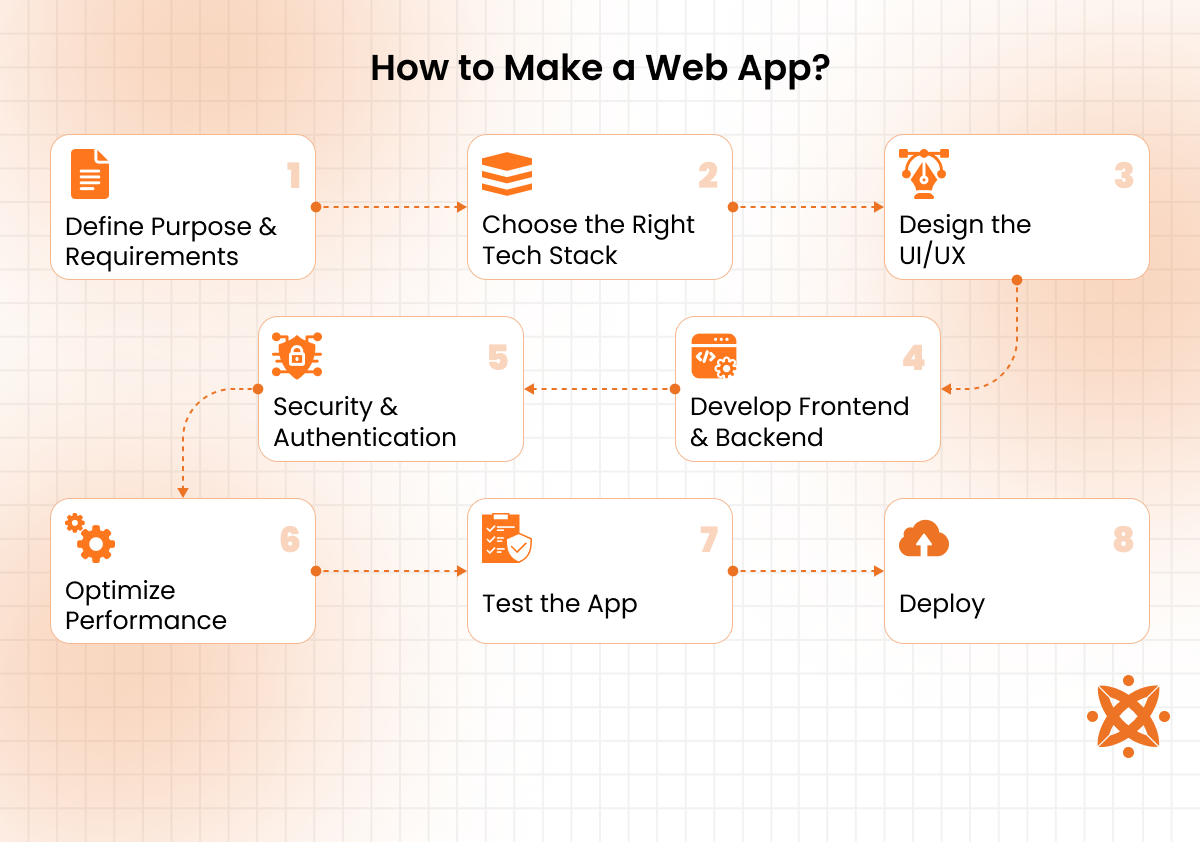
To make a web app, the below-mentioned steps are followed:
Step 1: Define the Purpose and Requirements
The first step is to identify the core purpose of the web app and define key functionalities. This involves market research, understanding user needs, and setting clear goals for the app's features, target audience, and business objectives.
Step 2: Choose the Right Tech Stack
The right technologies are paramount for performance and scalability. At this step, developers decide on frontend frameworks like React or Angular, backend technologies like Node.js or Django, and databases such as PostgreSQL or Firebase, depending on the app's complexity.
Step 3: Design the User Interface (UI) and User Experience (UX)
The Next step is to design the UI and UX of the web app. A well-designed UI enhances user engagement. Designers create wireframes, prototypes, and layouts using tools like Figma or Adobe XD to ensure smooth navigation, accessibility, and an intuitive user interface.
Step 4: Develop the Frontend and Backend
Frontend development focuses on creating the app's visual elements and interactive components using HTML, CSS, and JavaScript frameworks. Back-end development handles server-side logic, database management, and APIs to support app functionality.
Step 5: Implement Security and Authentication
At this stage, security and authentication features are implemented in the web app. Security measures like SSL encryption, user authentication, and secure database storage must be integrated to protect user data. Authentication methods such as OAuth, JWT, or two-factor authentication ensure secure access to the web app.
Step 6: Test and debug the Web App
Thorough testing is conducted to identify bugs, improve performance, and ensure an efficient user experience. Functional, usability, and security testing using tools like Selenium or Jest help refine the app before launch.
Step 7: Deploy the Web App
Once the app passes testing, it is deployed on cloud platforms like AWS, Google Cloud, or Vercel. Developers set up domain hosting, server configurations, and database connections to make the app accessible to users.
Step 8: Monitor, Maintain, and Update
Post-launch, continuous monitoring and performance optimisation are important. Regular updates, bug fixes, and feature enhancements based on user feedback ensure the long-term success and scalability of the web app.
What Is the Best Web Application Development Software?
The best web application development software are Visual Studio Code, Sublime Text, GitHub, Postman, and Docker. These tools help developers simplify coding, testing, version control, and deployment, ensuring web app development efficiency, security, and scalability.
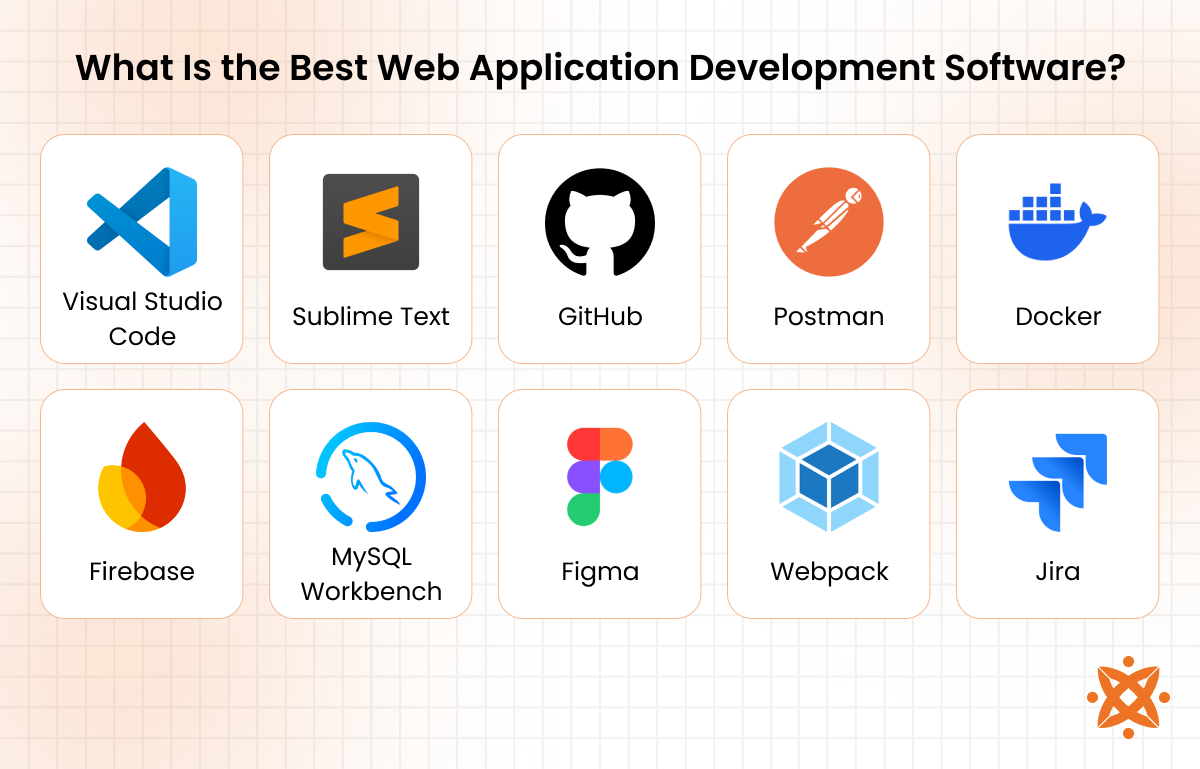
The best web application development software are as follows:
- Visual Studio Code: VS Code is a lightweight yet powerful code editor developed by Microsoft. It supports multiple programming languages and offers built-in Git integration, debugging tools, and an extensive extension marketplace. Its real-time collaboration feature makes it ideal for team-based web development.
- Sublime Text: Sublime text is a fast, feature-rich text editor known for its simplicity and customisation. It supports multiple programming languages, has a distraction-free mode, and offers powerful search, syntax highlighting, and plugin support, making it a favorite among web developers.
- GitHub: GitHub is a widely used version control platform that allows developers to collaborate, track changes, and manage code repositories. With features like pull requests, issue tracking, and continuous integration, GitHub simplifies web app development and deployment.
- Postman: Postman is a powerful API development and testing tool that enables developers to design, debug, and document APIs efficiently. It simplifies API testing with automated test scripts, ensuring smooth integration between front-end and back-end systems in web applications.
- Docker: Docker is a containerisation platform that simplifies application deployment by packaging applications and their dependencies into lightweight, portable containers. Docker ensures consistency across development, testing, and production environments, making web app deployment efficient.
- Firebase: Firebase is a backend-as-a-service (BaaS) platform by Google that provides real-time databases, authentication, hosting, and cloud functions. It is particularly useful for building scalable web apps with real-time synchronisation and serverless architecture.
- MySQL Workbench: MySQL Workbench is a comprehensive database design and management tool that allows developers to design, model, and optimise databases. It offers visual tools for schema design, SQL development, and performance monitoring, making database management more efficient.
- Figma: Figma is a collaborative UI/UX design tool that enables web designers and developers to create interactive prototypes, wireframes, and visual designs. With real-time collaboration features, Figma ensures a smooth workflow between designers and developers.
- Webpack: Webpack is a powerful module bundler that optimises JavaScript, CSS, and asset files for faster web applications. It enhances performance by minimising and bundling resources, ensuring efficient loading times and better user experience.
- Jira: Jira is a project management tool widely used in agile web development for tracking tasks, bugs, and project progress. It helps teams stay organised, plan sprints, and manage workflows efficiently for web application development projects.
What Is the Difference Between Web App Development and Web Development?
The main difference between web app development and web development is that web app development focuses on creating interactive applications that users engage with, while web development includes both static websites and dynamic web apps. Web development encompasses the entire process of building and maintaining online platforms, from simple informational websites to complex portals.
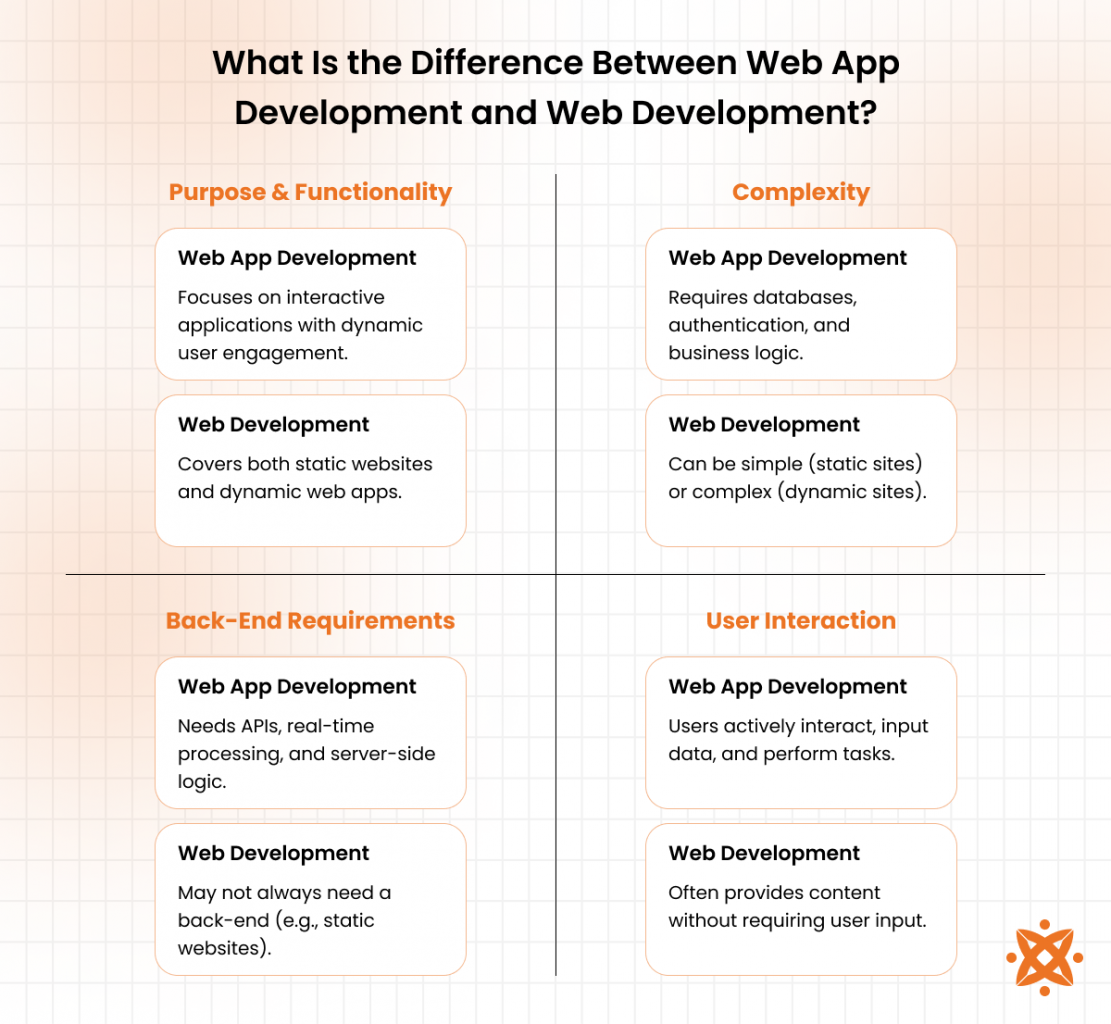
Web app development integrates databases, user authentication, and business logic to deliver highly functional and interactive experiences. Web apps require back-end services, APIs, and real-time data processing, making them more complex than traditional web development projects.
What Is the Difference Between a Web App and a Website?
The main difference between a web app and a website is that a web app is designed for interactive user engagement, while a website primarily delivers static or dynamic content. Websites provide information in the form of articles, blogs, and media, with limited interaction beyond navigation and form submissions.
Web apps, on the other hand, offer features like user authentication, real-time updates, and personalised experiences, functioning more like desktop or mobile applications. Unlike standard websites, web apps rely on client-side and server-side scripting to deliver better interactions, requiring back-end services to handle user data and transactions.
What Is the Difference Between a Web App and a Progressive Web App?
The main difference between a web app and a progressive web app (PWA) is that a PWA enhances a web app with offline capabilities, push notifications, and mobile-friendly optimisations. While both are interactive and dynamic, PWAs use modern web technologies like service workers and caching to enable fast loading speeds and offline functionality, mimicking the experience of a native mobile app.
Traditional web apps depend on a stable internet connection, whereas PWAs function partially or fully offline by storing data locally. PWAs are installed on a user's device without requiring an app store, bridging the gap between web and mobile applications.
How to Choose the Right Web App Development Company?
To choose the right web app development company, businesses must evaluate expertise, portfolio, and technical capabilities to ensure the best fit for their project needs. A reliable partner should offer scalable solutions, use modern technologies, and prioritise performance, security, and user experience. Companies also consider industry experience, communication standards, and post-launch support to guarantee long-term success.
Following are the tips for choosing the right web app development company:
- Evaluate Technical Expertise and Experience: A strong web app development company has expertise in modern front-end and back-end technologies, frameworks, and databases. Reviewing their portfolio helps assess their proficiency in developing custom web app development solutions customised to your needs.
- Assess Industry Experience and Past Projects: Companies with experience in your industry are more likely to understand your requirements and deliver efficient solutions. Reviewing case studies and previous projects provides insight into their approach, development process, and ability to solve complex challenges.
- Check Development Approach and Technology Stack: A reliable website and app development company follows industry best practices, such as agile development, DevOps, and CI/CD for continuous deployment. Ensure they use advanced responsive web app development techniques for optimal cross-device functionality.
- Evaluate Communication and Collaboration Standards: Effective communication is important when working with an outsource web app development team. Reliable companies provide clear project timelines, regular updates, and transparent collaboration tools to keep you involved throughout the development cycle.
- Analyse Post-Launch Support and Maintenance: A reputable web and mobile app development company offers post-launch support, bug fixes, and feature enhancements to keep your web app updated and secure. Ensuring long-term maintenance agreements prevents future operational disruptions.
- Consider Scalability and Security Measures: A good web app development company implements robust security protocols, including data encryption, authentication mechanisms, and compliance with industry regulations. Scalable architecture ensures your web app handles future growth and increased user demands.
Choosing the right web app development company is important for the success of your project. Intelivita is a trusted name in custom web app development, offering end-to-end solutions for businesses in the USA, UK, Canada, and India. Their expertise in scalable architecture, modern frameworks, and responsive design ensures that your web application meets the highest performance and security standards.
How Much Does It Cost to Develop a Web App?
It costs an average of £4,000 to £120,000 to develop a web app, depending on factors such as complexity, features, design, and development team location. Simple web apps with basic functionality fall on the lower end, while complex enterprise-level solutions with advanced features, integrations, and security measures cost significantly more.
The choice of custom web app development, third-party integrations, cloud hosting, and ongoing maintenance also influences development costs. Hiring an experienced web app development company ensures a balance between cost and quality, optimising scalability, security, and performance.
What Are the Best Practices for Web App Development?
The best practices for web app development are responsive design, security-first approach, efficient performance optimisation, and continuous testing and deployment. These ensure that web applications are scalable, secure, and provide a smooth user experience across devices. Implementing these practices helps build reliable, high-performing apps that meet business and user expectations.
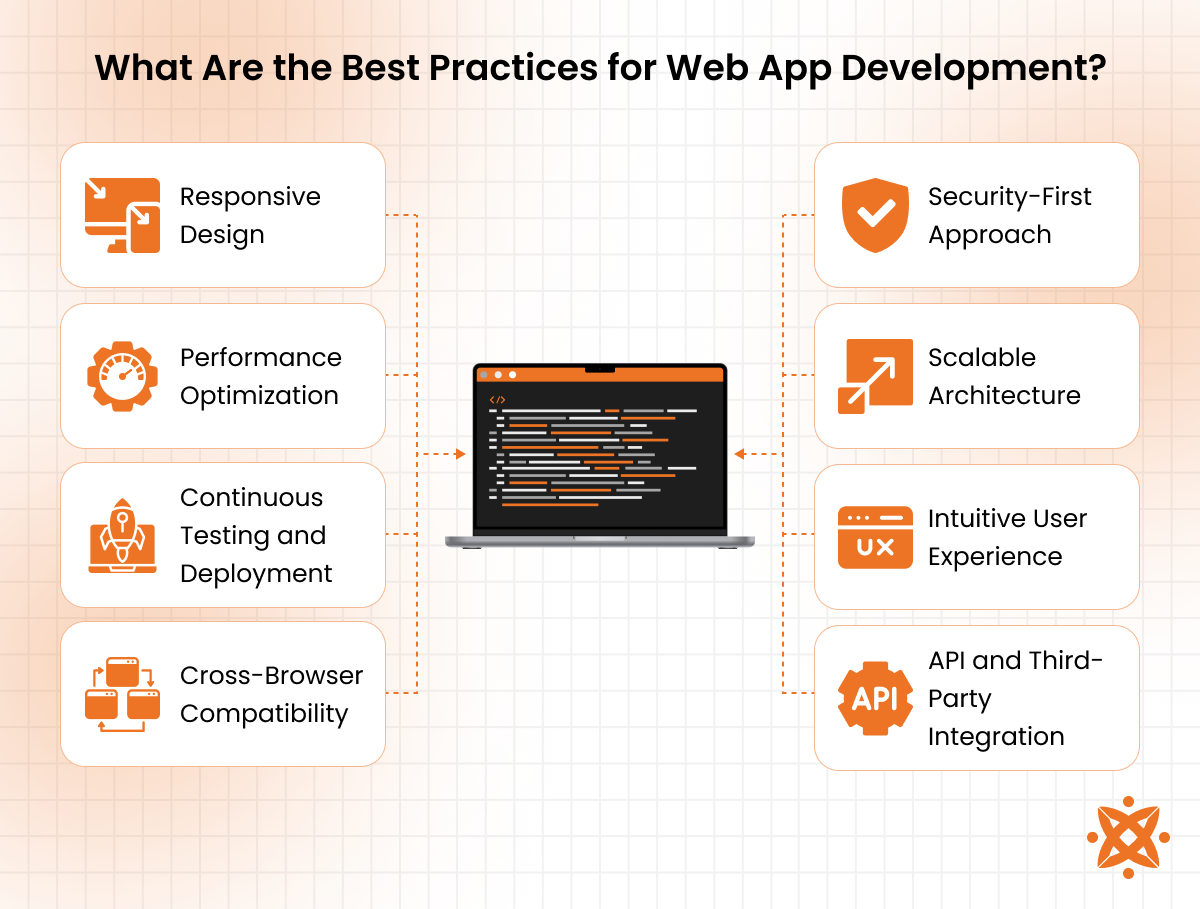
The best practices for web app development are as follows:
- Responsive Design: A web app is required to be accessible and fully functional across all devices, including desktops, tablets, and smartphones. Using flexible grids, media queries, and modern front-end frameworks ensures a consistent user experience across different screen sizes.
- Security-First Approach: Prioritising security measures such as encryption, secure authentication, and regular vulnerability testing helps protect user data from cyber threats. Implementing SSL certificates, secure APIs, and compliance with industry regulations ensures a trustworthy application.
- Performance Optimization: Web apps should load quickly and perform efficiently. Using techniques such as caching, content delivery networks (CDN), code minification, and database optimisation enhances speed and reduces server load.
- Scalable Architecture: Building a web app with a scalable backend infrastructure ensures it handles increased user traffic and feature expansion. Choosing cloud computing services and microservices architecture supports long-term growth.
- Continuous Testing and Deployment: Implementing automated testing and CI/CD pipelines ensures that bugs and issues are identified early. Regular updates and deployments improve the stability and functionality of the app.
- Intuitive User Experience (UX): A user-friendly interface with smooth navigation and clear calls to action enhances engagement. Using A/B testing and gathering user feedback helps refine the design and usability.
- Cross-Browser Compatibility: Ensuring the web app functions correctly across different web browsers prevents accessibility issues. Testing on Chrome, Firefox, Safari, and Edge ensures a consistent experience for all users.
- API and Third-Party Integration: Many web apps rely on external APIs for added functionality. Proper API management, error handling, and security practices ensure error-free data exchange and system efficiency.
What Are the Trends in Web App Development?
The top trends in web app development include progressive web apps (PWAs), AI-powered applications, serverless architecture, and enhanced cybersecurity. These trends shape modern web applications by improving performance, scalability, and security while offering an engaging user experience. Businesses adopting these innovations stay ahead in the competitive digital landscape.
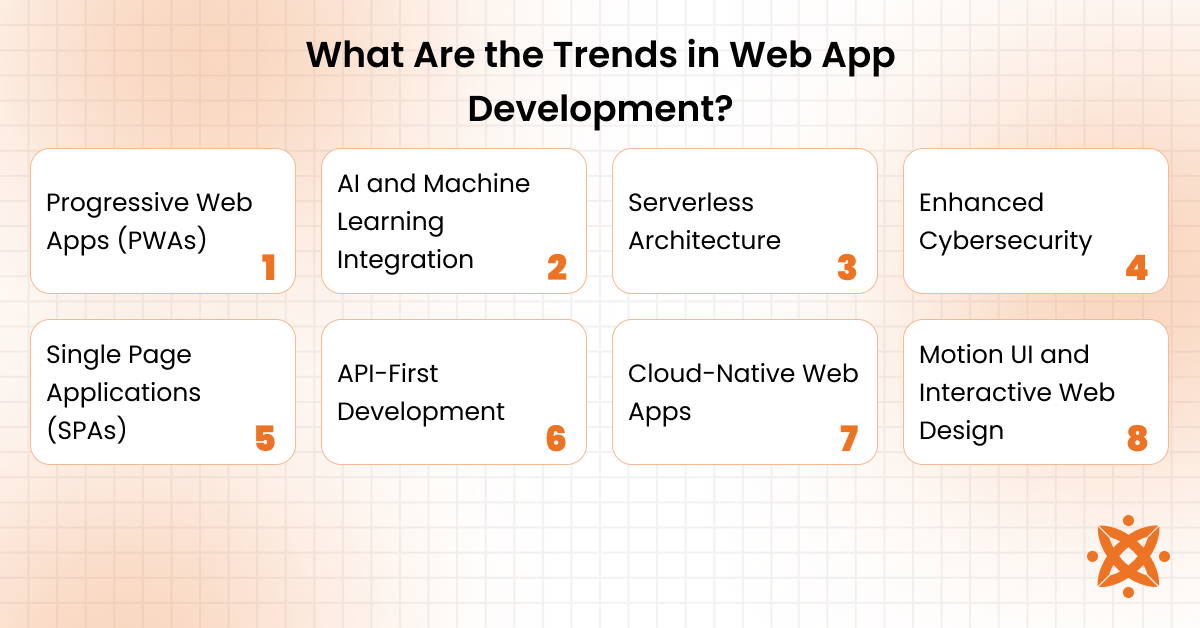
The top trends in web app development are as follows:
- Progressive Web Apps (PWAs): PWAs combine the best features of web and mobile applications, providing a fast, offline-capable, and app-like experience directly in a browser. They enhance user engagement and reduce reliance on native app stores.
- AI and Machine Learning Integration: Web applications utilise AI for automation, chatbots, personalised recommendations, and predictive analytics. Machine learning models enhance user experiences and improve decision-making for businesses.
- Serverless Architecture: Serverless computing eliminates the need for backend infrastructure management, enabling web apps to scale automatically. Platforms like AWS Lambda and Google Cloud Functions optimise cost and improve efficiency.
- Enhanced Cybersecurity: With rising cyber threats, web apps incorporate stronger security measures such as end-to-end encryption, multi-factor authentication (MFA), and AI-driven threat detection to protect user data.
- Single Page Applications (SPAs): SPAs improve web app speed and responsiveness by dynamically loading content instead of refreshing entire pages. Frameworks like React, Vue.js, and Angular support this approach for free navigation.
- API-First Development: The rise of microservices and headless architectures has made API-driven development a key trend. This allows businesses to create modular applications that integrate easily with various services.
- Cloud-Native Web Apps: Businesses are shifting towards cloud-native development for better scalability and reliability. Kubernetes, Docker, and cloud platforms like AWS and Azure enable the efficient deployment and management of web applications.
- Motion UI and Interactive Web Design: Modern web apps prioritise user engagement with dynamic animations, micro-interactions, and fluid transitions, enhancing the visual appeal and usability of applications.
Never Miss an Update From Us!
Sign up now and get notified when we publish a new article!
Dhaval Sarvaiya
Co-Founder
Hey there. I am Dhaval Sarvaiya, one of the Founders of Intelivita. Intelivita is a mobile app development company that helps companies achieve the goal of Digital Transformation. I help Enterprises and Startups overcome their Digital Transformation and mobile app development challenges with the might of on-demand solutions powered by cutting-edge technology.
